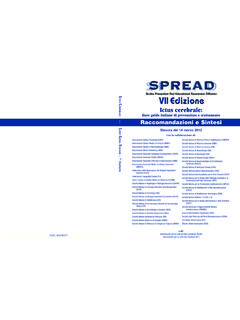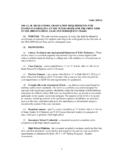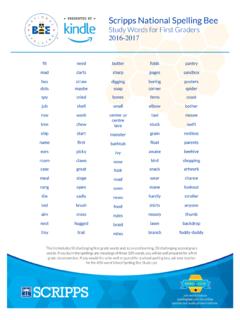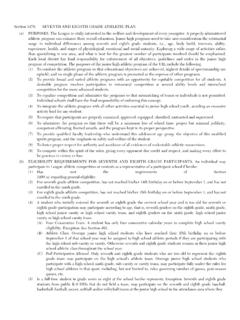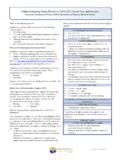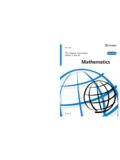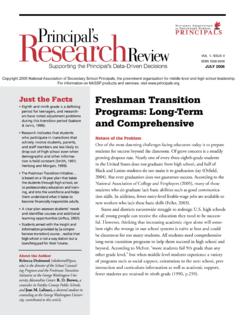Transcription of Introduction to the Ninth Edition : Antithrombotic …
1 DOI 2012;141;48S-52 SChest David D. Gutterman and Sandra Zelman LewisGordon H. Guyatt, Elie A. Akl, Mark Crowther, Holger J. Sch nemann, Practice GuidelinesChest Physicians Evidence-Based Clinical Thrombosis, 9th ed: American College ofAntithrombotic Therapy and Prevention of Introduction to the Ninth Edition : can be found online on the World Wide Web at: The online version of this article, along with updated information and ISSN:0012-3692) (written permission of the copyright article or PDF may be reproduced or distributed without the priorDundee Road, Northbrook, IL 60062. All rights reserved. No part of Copyright2012by the American College of Chest Physicians, 3300 Physicians. It has been published monthly since 1935. is the official journal of the American College of ChestChest 2012 American College of Chest Physicians by guest on February 7, from 48 SCHESTS upplementANTITHROMBOTIC THERAPY AND PREVENTION OF THROMBOSIS, 9TH ED: ACCP GUIDELINESI ntroduction to the Ninth Edition Correspondence to: Gordon H.
2 Guyatt, MD, FCCP, Department of Clinical Epidemiology and Biostatistics, McMaster University, Hamilton, ON, L8N 3Z5, Canada; e-mail: 2012 American College of Chest Physicians. Reproduction of this article is prohibited without written permission from the American College of Chest Physicians ( ). DOI: We would like to begin by acknowledging the contributions of the visionaries whose work on past editions of these guidelines have allowed the current panel to develop this Edition using the changes noted herein. First, James E. Dalen, respected clinician and researcher, while President of the American College of Chest Physicians (ACCP), had the foresight not only to propose the original consensus conference on the controversial issues of the indications for anti-thrombotics, antiplatelet agents, and thrombolytics for the prevention and treatment of cardiovascular disorders but also to invite Jack Hirsh, an extremely productive scientist and leader in the fi eld of throm-bosis, to join him in leading this important project.
3 Drs Hirsh and Dalen brought a panel of leading experts together for the fi rst Antithrombotic guide-line 1 i n 1 9 8 6 . D r D a l e n w a s c o - e d i t o r o f t h e fi rst six guidelines from 1986 to 2001. Dr Hirsh is, to an extraordinary extent, responsible not only for creating the platform that has made Anti-thrombotic Therapy and Prevention of Thrombo-sis, 9th ed: American College of Chest Physicians The Antithrombotic Therapy and Prevention of Thrombosis, 9th ed: American College of Chest Physicians Evidence-Based Clinical Practice Guidelines differs substantially from the prior ver-sions both in process and in content. In this Introduction , we describe some of the differences and the rationale for the changes. CHEST 2012; 141(2)(Suppl):48S 52S Abbreviations: A C C P 5 A m e r i c a n C o l l e g e o f C h e s t P h y s i c i a n s ; AT 6 5 Sixth ACCP Consensus Conference on Antithrombotic Therapy; AT7 5 Seventh ACCP Conference on Antithrombotic and Thrombolytic Therapy: Evidence-Based Guidelines; AT8 5 Antithrombotic and Thrombolytic Therapy: American College of Chest Physicians Evidence-Based Clinical Practice Guidelines (8th Edition ); AT9 5 Antithrombotic Therapy and Prevention of Thrombosis, 9th ed: American College of Chest Physicians Evidence-Based Clinical Practice Guidelines.
4 GRADE 5 Grades of Recommen-dations, Assessment, Development, and Evaluation Introduction to the Ninth Edition Antithrombotic Therapy and Prevention of Thrombosis, 9th ed: American College of Chest Physicians Evidence-Based Clinical Practice Guidelines Gordon H. Guyatt , MD , FCCP ; Elie A. Akl , MD , PhD, MPH ; Mark Crowther , MD ; Holger J. Sch nemann , MD , PhD , FCCP ; David D. Gutterman , MD , FCCP ; and Sandra Zelman Lewis , PhD Revision accepted August 31, 2011. Affi liations: From the Department of Clinical Epidemiology and Biostatistics (Drs Guyatt, Akl, and Sch nemann) and Depart-ment of Medicine (Drs Guyatt, Crowther, and Sch nemann), McMaster University Faculty of Health Sciences, Hamilton, ON, Canada; Departments of Medicine and Family Medicine (Dr Akl), State University of New York, Buffalo, NY; Cardiovascular Research Center (Dr Gutterman), Medical College of Wisconsin, Milwaukee, WI; and Evidence-Based Clinical Practice Guidelines and Clinical Standards (Dr Lewis), American College of Chest Physicians, Northbrook, IL.
5 Funding/Support: The Antithrombotic Therapy and Prevention of Thrombosis, 9th ed: American College of Chest Physicians Evidence-Based Clinical Practice Guidelines received support from the National Heart, Lung, and Blood Institute [R13 HL104758] and Bayer Schering Pharma AG. Support in the form of educa-tional grants was also provided by Bristol-Myers Squibb; Pfi zer, Inc; Canyon Pharmaceuticals; and sanofi -aventis US. Disclaimer: American College of Chest Physician guidelines are intended for general information only, are not medical advice, and do not replace professional medical care and physician advice, which always should be sought for any medical condition. The complete disclaimer for this guideline can be accessed at 2012 American College of Chest Physicians by guest on February 7, from / 141 / 2 / FEBRUARY, 2012 SUPPLEMENT 49 Sresponsibility for each article not to a thrombosis expert but to a methodologist who, in almost all cases, also is a practicing physician without important con-fl icts of interest 4,5 ( Table 1 ).
6 These editors of each article had specifi c training in ACCP s approach to rating the quality of evidence and grading strength of recommendations (see Evidence Summaries section). Further, building on the work of prior guide-line groups, 6 the process stipulated that although confl icted thrombosis experts could engage in discus-sion and even draft evidence summaries, they would be excluded from the fi nal decisions regard ing quality of evidence and direction and strength of recommenda-tions. Intellectual confl icts received the same atten-tion as fi nancial confl icts. Readers of the guidelines can fi nd in the online data supplements to AT9 articles a recommendation-by-recommendation accounting of the intellectual and fi nancial confl icts of each panel member. The most important changes in AT9 con-tent have fl owed directly from this change in process.
7 Evidence Summaries The Sixth ACCP Consensus Conference on Anti-thrombotic Therapy (AT6), 7 published in 2001, adopted an approach to rating quality of evidence and strength of recommendations 8 that presaged that of the Grades of Recommendations, Assessment, Development, and Evaluation (GRADE) working group, 9 i t s e l f a d o p t e d w i t h m i n o r m o d i fi cations for AT8 10 and for all ACCP guidelines. 11 AT8, like AT6 and the Seventh ACCP Conference on Antithrom-botic and Thrombolytic Therapy: Evidence-Based Guidelines (AT7), 12 underwent thorough editing and review of the quality of evidence, including in many cases a careful assessment of single studies by topic editors and the guideline executive committee. Nevertheless, many of the topic editors did not have methodologic training or, as was the case in AT8, spe-cifi c training in the ACCP-GRADE approach.
8 The result was that in AT8, the ACCP-GRADE approach often was not applied with optimal rigor, and authors Evidence-Based Clinical Practice Guidelines (AT9) possible but also for the advances from Antithrom-botic and Thrombolytic Therapy: American College of Chest Physicians Evidence-Based Clinical Practice Guidelines (8th Edition ) (AT8) to AT9. It was not only the creation of an expert panel a standard fea-ture of specialty society clinical practice guidelines from the outset that made the Antithrombotic guidelines extremely successful. Dr Hirsh, an accom-plished basic science researcher and a brilliant clin-ical trialist, deeply understood the value of what was to become more than a decade later evidence-based medicine. He recruited one of the world leaders in the burgeoning fi eld of clinical epidemiology, David Sackett, to play a major role in the guidelines.
9 Drs Hirsh and Sackett developed and applied an innovative system of rating the quality of evidence and strength of recommendations that was at the time unique to specialty guidelines. The combined impact of the authoritative, carefully considered recommen-dations and explicit acknowledgment of the quality of evidence and strength of recommendations immedi-ately made these guidelines the reference standard for Antithrombotic therapy around the world. Under Dr Hirsh s leadership, the guidelines more than kept pace with advances in the science of guide-line methodology and continued to improve with each iteration. Each new Edition provided a model incorporating not only the latest evidence regarding Antithrombotic therapy but also advances in special-ty-based guidelines and therefore maintained preem-inence in the fi eld of thrombosis.
10 As Dr Hirsh was stepping down from the leader-ship of the guidelines in 2007, his insight led him to question the reliance on expert opinion that provided the basis for the fi rst eight iterations of the anti-thrombotic guidelines. Reviewing his experience and in the process giving new life to an idea suggested decades earlier but seldom applied 2 Dr Hirsh con-cluded that the confl ict of interest of leading experts was highly problematic. 3 Furthermore, the problem arose not only from their fi nancial but equally or per-haps more important, their intellectual confl ict of interest. This revelation and the changes in process that Dr Hirsh suggested as a solution to the problem had a profound impact on the leadership to whom he was passing the torch. These changes underlie all the innovations in AT9. The New Process in AT9 Dealing With Conflict of Interest The solution that Dr Hirsh proposed was endorsed by the ACCP leadership and implemented in AT9.
